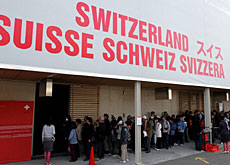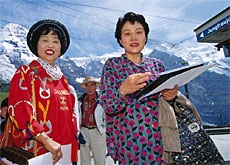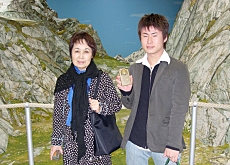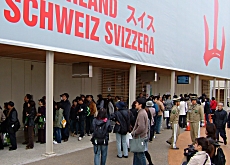Swiss hit the mark at Expo 2005

The Swiss pavilion at the 2005 World Exhibition in Japan is proving to be a hit with visitors, attracting a steady flow of 5,000 people per day.
Organisers of Switzerland’s presence at the Expo say the interactive nature of the pavilion, built in the shape of an alpine mountain range, is one reason for the success.
Expo 2005 opened last month just outside the Japanese city of Nagoya. An estimated 15 million people are expected to visit the exhibition during its six-month run.
Swiss officials hope that up to 1.5 million people – ten per cent of all visitors to the Expo – will find the time to tour the country’s exhibition space.
“We are on track to meet this target,” said Manuel Salchli, head of the Swiss delegation at the Expo.
One of the highlights of a tour of the Swiss pavilion – known as “The Mountain” – is a terrace viewpoint, from which visitors are invited to gaze out over an artificial alpine scene.
Inside the mountain, a dimly-lit exhibition space displays a selection of artefacts related to Switzerland, including Albert Einstein’s Swiss passport and the ski helmet worn by Bernhard Russi when he took gold at the 1972 Winter Olympics in Sapporo.
Long queues
The Swiss pavilion is located in a corner of the 173-hectare Expo site reserved for a number of European nations, including Austria, Britain, Ireland and the Netherlands.
According to Salchli, Switzerland is the only country in this particular zone which regularly has long queues of visitors outside its pavilion.
“Our pavilion has been well received, even if the Japanese media tend to refer to what Switzerland is doing here only in terms of our terrace viewpoint and the raclette [served in the adjacent Swiss restaurant],” he told swissinfo.
Visitors to the Swiss pavilion are given a flashlight which they can use to point at exhibits and trigger an audio commentary in either English or Japanese.
“Many people have praised our decision to take a different approach to that seen in other pavilions, where you very often only have projection screens, video and multimedia presentations,” said Salchli.
The pavilion director, who is head of world exhibitions at the Swiss foreign ministry, is also proud of the fact that Switzerland has been commended by many visitors for employing Japanese-speaking Swiss staff to act as guides.
He points out that many other countries have only employed locally-recruited Japanese guides.
Guiding hand
Salchli, who heads a 70-strong staff at the Swiss pavilion, expressed surprise at the extent to which Japanese visitors feel the need to be guided around the exhibition.
“The Japanese really want to be led from the beginning to the end [of the exhibition], either with written signs or a personal guide.”
Salchli’s view is shared by Clelia Kanai, a 27-year-old student of Japanese who is one of around 40 guides employed to assist visitors to the Swiss pavilion.
“The Japanese tend to prefer it if they are assisted and guided around,” said Kanai, who is half-Swiss, half-Japanese.
“I’ve really noticed while working at the Expo that they definitely have this group mentality.”
She adds that the Japanese tend to need detailed explanations when they arrive at the Swiss pavilion about how to use the pocket lamps handed out to visitors.
Working at the exhibition has also given Kanai an insight into the similarities and differences between the Swiss and Japanese.
She thinks Swiss visitors to the pavilion would probably not need to be given as much of a helping hand as the Japanese.
But the two nations also have much in common: “Both the Japanese and the Swiss are known for the [importance they place on] cleanliness, reliability and perfectionism.
“And the people of both countries share the same island mentality.”
swissinfo, Christian Raaflaub in Aichi, Japan
The first World Expo took place in London in 1851.
The most recent global exhibitions have taken place as follows:
1970: Osaka, Japan
1992: Seville, Spain
1998: Lisbon, Portugal
2000: Hanover, Germany
2005: Aichi, Japan
The next World Expo is due to take place in the Chinese city of Shanghai in 2010.

In compliance with the JTI standards
More: SWI swissinfo.ch certified by the Journalism Trust Initiative




You can find an overview of ongoing debates with our journalists here. Please join us!
If you want to start a conversation about a topic raised in this article or want to report factual errors, email us at english@swissinfo.ch.